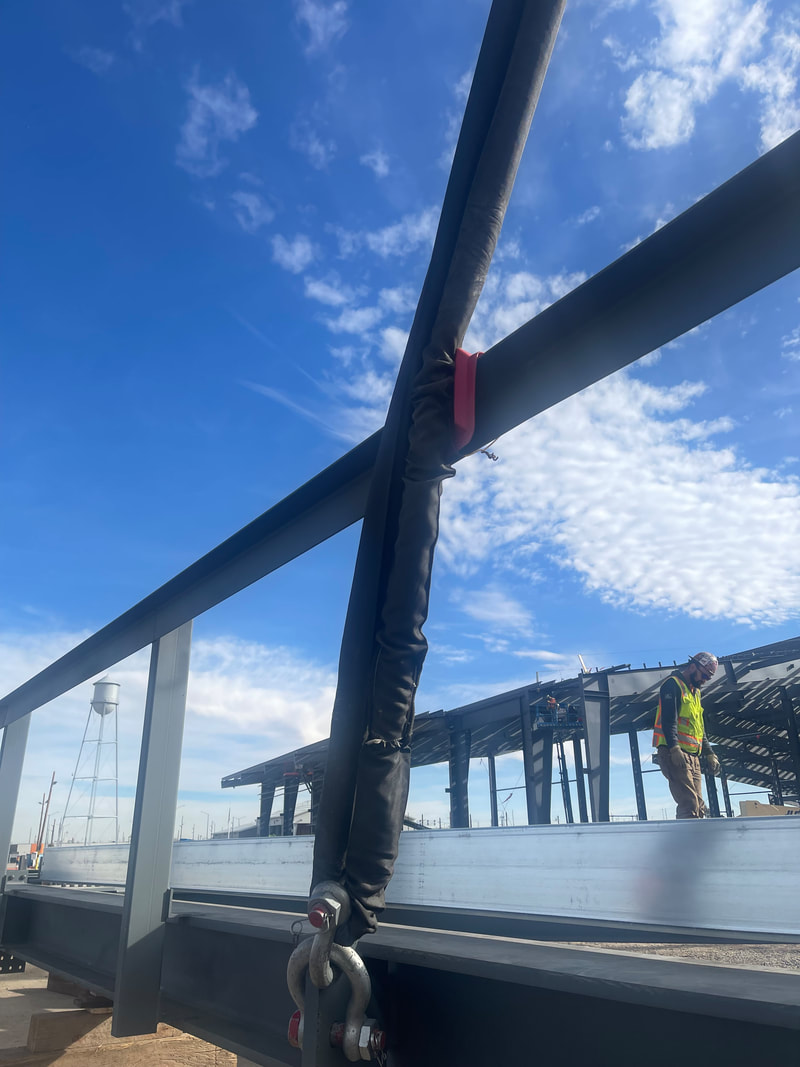|
Safe rigging practices are essential for the safety of everyone working near crane activities on a job site. Improper rigging techniques can lead to serious accidents, injuries, and damage to property. There is a wide variety of different rigging methods that can be applied in various lifting scenarios and it’s crucial to have the correct knowledge in selecting the correct method in each case. Rigging for steel erection presents unique challenges. Read on for best practice reminders on inspection, selection, and communication. Inspection and training First and foremost, employees need to ensure that all rigging equipment is inspected and maintained regularly. This includes wire rope, chains, nylon, polyester, hooks, and other hardware used for lifting and moving loads. Any equipment showing signs of wear such as, cuts, abrasions, severe wear, broken wires, cracked fittings, chemical burns, UV damage and distortion should be immediately taken out of service and replaced. Regular inspections and maintenance help to prevent equipment failure and ensure that all rigging gear is in good working condition. Proper training for riggers is another critical aspect of safe rigging practices. Workers involved in rigging operations need to receive comprehensive training on the safe use of rigging equipment, as well as the identification of potential hazards and proper procedures for lifting and moving loads. Additionally, workers should be trained to understand load capacities, weight estimation, center of gravity, and the importance of balancing and securing loads to prevent accidents. Employers should also keep their employees training fresh as new standards, practices, rigging hardware is always changing. Selection for steel erection When it comes to rigging for steel erection, the selection of the appropriate rigging is critical. Qualified riggers should carefully choose the right rigging and hardware to be used based on the type and weight of the load being lifted. It is important to consider factors such as the shape, size, and center of the load to determine the most suitable rigging equipment for the job. Using the incorrect rigging can compromise safety and lead to serious accidents. For example, choosing a flat webbed nylon sling to hoist a steel beam with sharp edges could result in the rigging getting cut and dropping the load. A safer rigging practice in this scenario would be to use an Inner Wire Rope Core Steel Choker (IWRC). It’s also best to use softeners on the corners of a load that touch the selected rigging, and it’s extremely important to use the correct size sling. The saying “bigger is always better” is not a safe practice when it comes to selecting rigging. If you were to choose to use a 1 in. IWRC choker on a 300 lbs. beam in a choke hitch, the load would likely slide out of the rigging. Hoisting communication Furthermore, steel erectors must establish clear communication protocols during hoisting operations. Effective communication among rigging personnel, crane operators, and other workers is essential for ensuring the safe and efficient movement of loads. Using standardized hand signals or two-way radios can help to minimize the risk of misunderstandings and errors during a lift. Workers that are giving the signals to the operator need to have proper training to do so. Steel erectors should always conduct a thorough assessment of the area in which loads will be hoisted overhead before commencing hoisting operations. This includes evaluating the ground conditions, overhead obstructions, and the presence of power lines or other potential hazards. Clearing a safe path for the movement of overhead loads and securing the area to prevent unauthorized access is also critical. The most effective way to secure an area is to set up a hard barricade such as a fence. At a minimum, red rope or red danger tape should be used around the perimeter with signage that identifies the hazards. We all need to adhere to all relevant safety regulations and standards governing rigging operations. This includes Compliance with OSHA and industry-specific guidelines for rigging and lifting operations. When receiving new rigging on a job site, we always need to make sure we understand and train our qualified riggers on the rigging manufacturers rules and guidelines on safe use/storage of the rigging. By staying informed about the latest safety standards and best practices, steel erectors can ensure that their rigging operations meet the highest safety standards and minimize the risk of accidents and injuries. In conclusion, safe rigging practices are vital for the success and safety of steel erectors. By following proper inspection and maintenance protocols, providing comprehensive training, selecting the appropriate rigging gear, establishing clear communication, conducting thorough assessments, and adhering to safety regulations, steel erectors can create a safe and productive work environment for their workers while ensuring the successful completion of their projects. Prioritizing safe rigging practices not only protects our workers and equipment but also contributes to the overall safety culture. Resources:
SEAAs Member’s SteelPros Training Portal. Topics available include how to select, inspect and use special rigging equipment, use and interpret hand signal, tie knots used in rigging, determine the center of gravity of a load, and advanced rigger. OSHA 1926 Subpart R OSHA Steel Erection eTool, Cranes in Steel Erection Subpart CC – Cranes and Derricks in Construction: Qualified Rigger This Safety Flash was contributed by Austin Reiner, Safety Manager, Derr & Gruenwald Construction, in cooperation with SEAA’s Safety & Education Committee. It’s designed to keep members informed about ongoing safety issues and to provide suggestions for reducing risk. Best practices are gathered from a variety of sources. They may be more or less stringent than individual corporate policies and are not intended to be an official recommendation from SEAA. Always get approval and direction from your company officers on any new practice or procedure as these best practices may not work for all situations. Everyone benefits when a worker avoids injury. Submit your ideas for Safety Flash to [email protected]. Comments are closed.
|





 RSS Feed
RSS Feed
